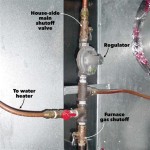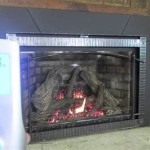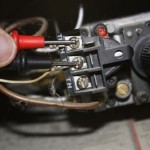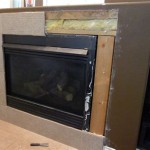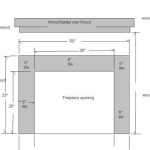Faux Stone Fireplace Design Ideas
Faux stone fireplaces provide a cost-effective and versatile alternative to natural stone, enabling homeowners to achieve the aesthetic appeal of stone without the significant expense and installation challenges. The material's lightweight nature and ease of installation make it a popular choice for both new construction and renovation projects. With a wide range of colors, textures, and styles available, faux stone can be seamlessly integrated into various interior design schemes, from rustic and traditional to modern and contemporary.
Unlike natural stone, which requires specialized tools and expertise for cutting and installation, faux stone can be installed with basic carpentry tools and adhesive. This simplifies the construction process and reduces labor costs. Furthermore, the consistent size and shape of faux stone panels or veneers contribute to a more uniform and aesthetically pleasing finish. Its non-porous nature also makes it resistant to moisture and staining, simplifying maintenance and ensuring long-term durability.
Selecting the Right Faux Stone Material
The first crucial step involves selecting the appropriate faux stone material. Several options are available, each offering unique characteristics in terms of appearance, durability, and cost. Manufactured stone veneer (MSV) is a common choice, composed of concrete and pigments molded to resemble natural stone. MSV offers a realistic stone appearance and is available in a wide array of colors and textures. Polyurethane faux stone panels are another popular option, known for their lightweight nature, ease of installation, and resistance to moisture.
The selection process needs a consideration of the overall design aesthetic. For a rustic or traditional setting, stacked stone or dry-stacked ledge stone patterns are suitable options. These patterns mimic the appearance of natural stone walls constructed without mortar, providing a rugged and textured look. For a more contemporary or minimalist design, smoother, more uniform stone patterns, such as ledgestone or ashlar patterns, should be considered. These patterns offer a cleaner, more refined aesthetic.
The color palette also plays a crucial role in achieving the desired look. Neutral tones, such as grays, beiges, and browns, provide a versatile backdrop that complements a variety of interior design styles. Lighter colors can brighten a space and create a more open feel, while darker colors can add depth and drama. It is advisable to obtain samples of the faux stone material and assess them in the actual lighting conditions of the room to ensure they complement the existing color scheme.
Designing the Fireplace Surround
The design of the fireplace surround is paramount in creating a visually appealing and functional focal point. The surround encompasses the area surrounding the firebox and can extend to the ceiling, creating a dramatic statement, or be limited to a smaller section, depending on the design preferences and the size of the room. The size and shape of the surround should be proportionate to the size of the fireplace and the overall dimensions of the room.
Consider incorporating architectural elements, such as a mantel, corbels, or pilasters, to enhance the visual appeal of the fireplace. A mantel provides a decorative shelf for displaying artwork, photographs, or other cherished items. Corbels, decorative brackets that support the mantel, can add a touch of elegance and sophistication. Pilasters, decorative columns that flank the fireplace opening, can further enhance the architectural detail.
The integration of other materials, such as wood, metal, or tile, can add visual interest and texture to the fireplace surround. For example, a wood mantel can provide a warm and inviting contrast to the cool texture of the faux stone. Metal accents, such as a metal fireplace screen or decorative metal inserts, can add a touch of industrial chic. Tile accents, such as a tile hearth or decorative tile borders, can further enhance the design.
Installation Techniques and Considerations
Proper installation is essential for ensuring the longevity and aesthetic appeal of a faux stone fireplace. Before beginning the installation process, ensure that the substrate, the surface onto which the faux stone will be applied, is clean, dry, and structurally sound. If the substrate is uneven or damaged, it may need to be repaired or replaced before proceeding.
The manufacturer's instructions should be carefully followed, regarding the recommended adhesive and installation techniques. Apply the adhesive evenly to the back of the faux stone panels or veneers using a notched trowel. Press the stone firmly onto the substrate, ensuring proper alignment and spacing. Use shims to maintain consistent spacing between the stones, if necessary. Once the adhesive has cured, remove the shims and fill any gaps with grout or mortar, matching the color of the faux stone.
Consider the weight of the faux stone and ensure that the underlying structure can support the added load. In some cases, it may be necessary to reinforce the wall or floor to accommodate the weight of the faux stone. For taller installations, proper anchoring is essential to prevent the faux stone from detaching from the wall. Consult with a qualified contractor or structural engineer if you have any concerns about the structural integrity of the installation.
Pay attention to detail during the installation process. Cut the faux stone precisely to fit around corners, edges, and other architectural features. Use a wet saw or angle grinder with a diamond blade to make clean, accurate cuts. Carefully blend the transitions between different types of faux stone or other materials to create a seamless and visually appealing finish.
Once the installation is complete, inspect the fireplace for any imperfections or areas that need to be touched up. Apply a sealant to protect the faux stone from moisture and staining. Clean the fireplace regularly with a mild detergent and water to maintain its appearance. By following these guidelines, homeowners can create a beautiful and durable faux stone fireplace that will enhance the ambiance of their home for years to come.

43 Top Fireplace Interior Design Stacked Stone Fireplaces Faux Veneer

Stone Fireplace Design And Remodel

Stone Fireplace Design And Remodel

12 Stacked Stone Fireplace Ideas For Optimal Coziness

Stone Veneer Fireplace Ideas That Will Warm Up Your Home Ply Gem

Natural Stacked Stone Veneer Fireplace Ideas

Faux Stone Fireplace Entertainment Center Genstone

40 Stone Fireplace Designs From Classic To Contemporary Spaces Design Mantel

ᑕ❶ᑐ Faux Stone Electric Fireplace Where Does It Match Best

50 Sensational Stone Fireplaces To Warm Your Senses
Related Posts

